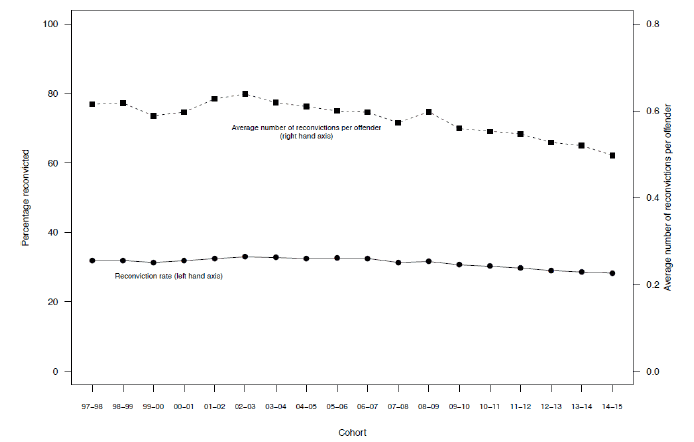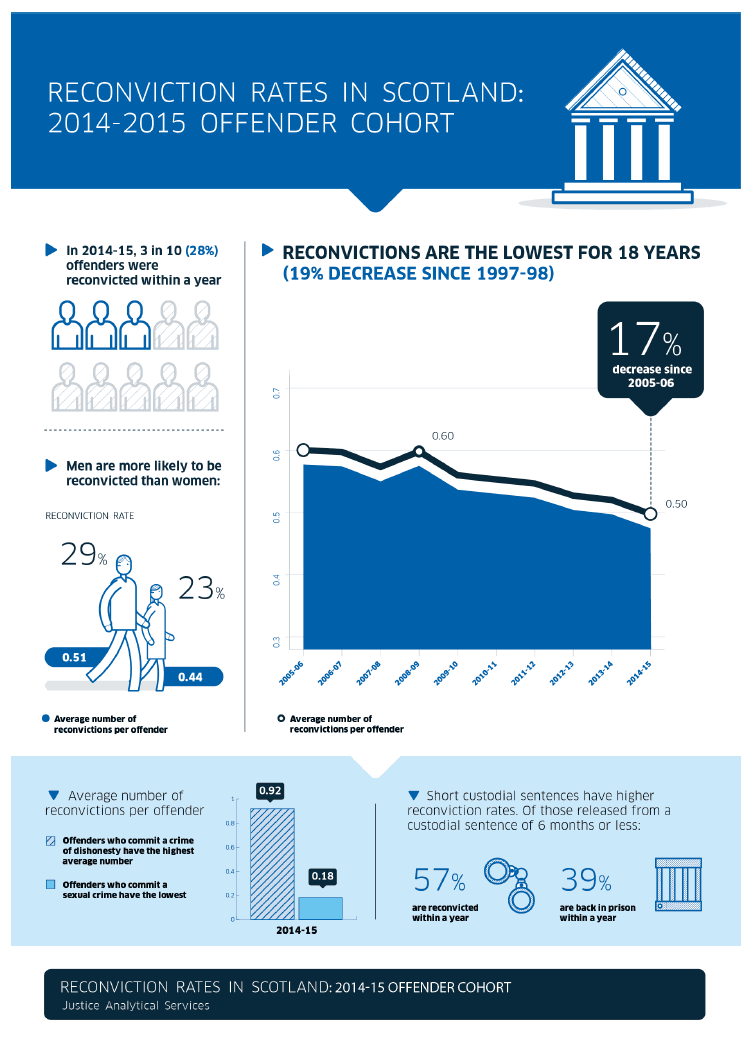Reconviction rates in Scotland: 2014-2015 offender cohort
Analysis of trends in reconviction statistics up to the latest cohort of 2014 to 2015.
Reconviction Rates in Scotland: 2014-15 Offender Cohort
This bulletin forms part of the Scottish Government series of statistical bulletins on the criminal justice system. Statistics are presented on the number of individuals who were released from a custodial sentence or given a non-custodial sentence in 2014-15 and then subsequently reoffended in 2015-16, along with selected trends.
Both the reconviction rate, a measure of the proportion of offenders who are reconvicted, and the average number of reconvictions per offender have decreased since 2013-14, continuing a gradual decline over the past 18 years. Since 2013-14, the reconviction rate has fallen by 0.3 percentage points, from 28.5% to 28.2% and the average number of reconvictions per offender has fallen by nearly 4%, from 0.52 to 0.50 ( Chart 1 and Table 1).
Chart 1: Reconviction rate and the average number of reconvictions per offender: 1997-98 to 2014-15 cohorts

Reconviction Rates in Scotland: 2014-15 Offender Cohort

Key points
Headline figures for the 2014-15 cohort
( Table 1)
- Both the reconviction rate and average number of reconvictions per offender are at their lowest values for 18 years. Between 2005-06 and 2014-15, the reconviction rate decreased by 4.3 percentage points from 32.5% to 28.2%. In the same period, the average number of reconvictions per offender decreased by 16.7% from 0.60 to 0.50.
Age and gender
- Male offenders have more reconvictions on average than female offenders. In 2014-15, the average number of reconvictions per offender for male offenders was 0.51 which is 15.9% higher than the value of 0.44 for female offenders ( Table 2).
- Over the longer term there has been a fall in the average number of reconvictions per offender for younger offenders. In 1997-98, the average number of reconvictions per offender in the under 21 age group was 0.93 and it has decreased by 31.2% to 0.64 in 2014-15. Over the same period, the average number of reconvictions per offender for the 21 to 25 age group decreased by 26.5% from 0.68 to 0.50 ( Table 3).
- In contrast to this longer term decrease, the average number of reconvictions per offender for individuals aged under 21 has increased over the preceding 2 years, by 10% from 0.58 in 2012-13 to 0.64 in 2014-15. Both men and women under 21 saw an increase in the average number of reconvictions per offender, for men under 21 the average number of reconvictions increased by 7.6% from 0.61 to 0.66, while for women this increased by 11.6% from 0.43 to 0.48 reconvictions per offender since 2012-13 ( Table 5)
- The average number of reconvictions per offender for the older age groups have generally increased over the last decade. Between 2005-06 and 2014-15, the average number of reconvictions per offender increased by 14.3% for the 31 to 40 age group, from 0.49 to 0.56, and by 12.9% for the over 40 age group, from 0.31 to 0.35 ( Table 3).
Index crime
( Table 6)
- As in previous years, offenders who commit a crime of dishonesty have the highest average number of reconvictions per offender (0.92 in 2014-15), whereas offenders who commit a sexual crime have the lowest (0.18 in 2014-15), compared to offenders that committed other crimes.
- Since 2013-14, the largest decrease in the average number of reconvictions per offender is for those who committed 'other crimes and offences', which includes crimes against public justice and handling offensive weapons. Reconvictions for this group decreased by 9.4% from 0.53 to 0.48. Over the same time period, the average number of reconvictions per offender increased for those convicted of sexual crime, by 12.5% (from 0.16 to 0.18), and for offenders who committed a drug offence by 9.1% (from 0.33 to 0.36), the first increase since 2008-09.
Index disposal [1] and sentence length
- Offenders with an index disposal of a Community Payback Order ( CPO) in 2014-15 had an average number of reconvictions per offender of 0.58 ( Table 8). This is a 3.6% increase on the previous cohort, when it was 0.56. But this average was 6.5% lower than the figure of 0.62 for those offenders with index disposals of Community Service Orders and Probation Orders in 2009-10, immediately prior to the introduction of CPOs.
- Offenders given a Drug Treatment and Testing Order ( DTTO) have the highest average number of reconvictions per offender compared to other disposals, with a value of 1.71 for the 2014-15 cohort. This is a 1.2% decrease on the previous year when it was 1.73, and the average number of reconvictions for DTTOs has decreased by 9% in the last ten years from the 2005-06 value of 1.88 ( Table 8).
- The average number of reconvictions per offender for those given a Restriction of Liberty Order ( RLO) has decreased by 1.7% since 2013-14, from 0.60 to 0.59 ( Table 8), and by 51.6% since 2005-06, from 1.22.
- Offenders released from a custodial sentence had an average number of reconvictions per offender of 0.85, the same as the previous 2013-14 cohort ( Table 8). As in previous years, those released from shorter sentences of 3 months or less have, on average, a higher number of reconvictions (1.25) than those released from longer custodial sentences, such as between 3 and 6 months (1.16) and over 4 years (0.13) ( Table 9). However, this difference may be explained by the type of offenders who are more likely to receive short custodial sentences; these individuals typically commit relatively low level crimes such as shoplifting but more often, in higher volumes and are more likely to be reconvicted.
Contact
Email: Mariken Schipper
Phone: 0300 244 4000 – Central Enquiry Unit
The Scottish Government
St Andrew's House
Regent Road
Edinburgh
EH1 3DG
There is a problem
Thanks for your feedback